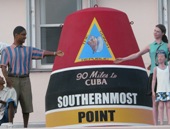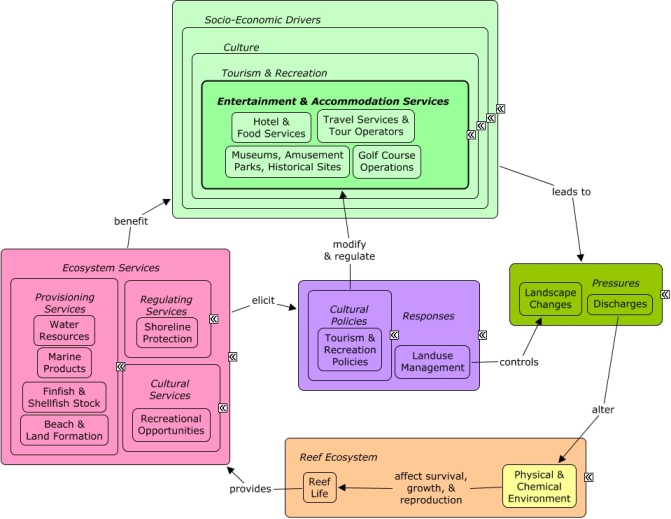ReefLink Database

Museums, Amusement Parks, Historical Sites
Industries involved in the Museums, Amusement Parks, and Historical Sites subsector of the Entertainment and Accommodation Services sector preserve and exhibit objects, sites, and natural wonders of historical, cultural, and educational value, and operate amusement parks for public entertainment.
CMap

CMap Description
Tourism & recreation requires construction of hotels, restaurants, docks, marinas, beaches and natural areas, which contribute to landscape changes and alter pollutant runoff into coastal systems. Tourism activities involving contact uses (boating, swimming, fishing) may cause physical damage to reef species,. Tourism & recreation sectors directly benefit from many ecosystem services, including the aesthetic value of the reef and clean, calm waters, which provide recreational opportunities and contribute to the cultural identity of the local community. The reef ecosystem also provides seafood and marine products, such as ornamental jewelry and other souvenirs. Decision-makers can enact policies to increase tourism, alter the location or intensity of recreational activities, or educate the public to modify their behavior. Decision-makers can enact policies to increase tourism, guide the activities of tourists, or alter the location or number of service providers through city planning, zoning, and permitting.Citations
| Citation | Year | Study Location | Study Type | Database Topics |
|---|---|---|---|---|
| Perger, R; Vargas, R; Wall, A. 2011. Johngarthia cocoensis, a new species of Gecarcinidae MacLeay, 1838 (Crustacea, Decapoda, Brachyura) from Cocos Island, Costa Rica. Zootaxa 57-68. | 2011 | South & Central America; US Pacific & Hawaii; Costa Rica | Lobster, Crab, & Shrimp; Museums, Amusement Parks, Historical Sites | |
| Roche, RC; Abel, RL; Johnson, KG; Perry, CT. 2011. Spatial variation in porosity and skeletal element characteristics in apical tips of the branching coral Acropora pulchra (Brook 1891). Coral Reefs 30:195-201. | 2011 | Museums, Amusement Parks, Historical Sites | ||
| Williams, RB; Moore, PG. 2011. An annotated catalogue of the marine biological paintings of Thomas Alan Stephenson (1898-1961). Archives of Natural History 38:242-266. | 2011 | Australia | Algae; Anemones & Zooanthids; Museums, Amusement Parks, Historical Sites | |
| Butler, A. J., T. Rees, P. Beesley, and N. J. Bax. 2010. Marine Biodiversity in the Australian Region. PLoS One 5:e11831. | 2010 | Australia | Marine Protected Areas; Museums, Amusement Parks, Historical Sites | |
| Tsuda, R. T., J. R. Fisher, P. S. Vroom, and I. A. Abbott. 2010. New records of subtidal benthic marine algae from Wake Atoll, Central Pacific. Botanica Marina 53:19-29. | 2010 | US Pacific & Hawaii; Micronesia; Marshall Islands | Algae; Museums, Amusement Parks, Historical Sites | |
| Washburne, R. and Wagar, J. 2010. Evaluating Visitor Response to Exhibit Content. Curator: The Museum Journal 15:248-256. | 2010 | US Pacific & Hawaii | Museums, Amusement Parks, Historical Sites; Tourism & Recreation | |
| Justine, J. L., C. Dupoux, and T. H. Cribb. 2009. Resolution of the discrepant host-specificity of Pseudorhabdosynochus species (Monogenea, Diplectanidae) from serranid fishes in the tropical Indo-Pacific. Acta Parasitologica 54:119-130. | 2009 | US Pacific & Hawaii; Australia; New Caledonia | Museums, Amusement Parks, Historical Sites | |
| Newell, C. 2008. USS Kitty Hawk docks after final voyage. Jane's Defence Weekly. | 2008 | US Pacific & Hawaii; Japan | Artificial Habitat; Coastal Defense; Docks & Marinas; Large Ships; Military; Museums, Amusement Parks, Historical Sites | |
| Pennisi, E. 2008. Museums: Smithsonian takes the plunge with ocean exhibit. Science 321:1617. | 2008 | Museums, Amusement Parks, Historical Sites | ||
| Stevely, J. and D. Sweat. 2008. Exploring the potential and protecting the resources: Florida's marine sponges. Sea Grant, Gainesville, FL. | 2008 | Florida | Commercial Fisheries; Cultural Policies; Cultural Protections; Fishing Sector; Hotel & Food Services; Invertebrate Harvest; Lobster, Crab, & Shrimp; Museums, Amusement Parks, Historical Sites; Sponges | |
| McCarthy, M., G. Henderson, and S. Batos. 2007. The heritage of the deep: Finding s/s Stefano. Nase More 54:233-238. | 2007 | Australia | Field Study & Monitoring; Remote Sensing | Museums, Amusement Parks, Historical Sites |
| Mikkelsen, P. M. and J. Cracraft. 2001. Marine biodiversity and the need for systematic inventories. Bulletin of Marine Science 69:525-534. | 2001 | Field Study & Monitoring | Algae; Banks, Credit, & Securities; Biological Monitoring, Mapping, & Scientific Research; Climate; Collaboration & Partnering; Echinoderms; Landscape Conservation & Restoration; Marine Worms; Molluscs; Museums, Amusement Parks, Historical Sites; Seastars; Snails & Conch; Sponges | |
| Salm, R. V. and S. L. Coles. 2001. Coral bleaching and marine protected areas. Page 118 in Proceedings of the Workshop on Mitigating Coral Bleaching Impact Through MPA Design, Bishop Museum, Honolulu, Hawaii, 29-31 May 2001. Asia Pacific Coastal Marine Program Report # 0102. Honolulu, Hawaii,. | 2001 | US Pacific & Hawaii | Marine Protected Areas; Museums, Amusement Parks, Historical Sites | |
| Hooper, J. N. A., S. E. List-Armitage, J. A. Kennedy, S. D. Cook, and C. A. Valentine. 1999. Sponges of the low isles, great barrier reef: an important scientific site, or a case of mistaken identity ? Memoirs of the Queensland Museum 44:249-262. | 1999 | US Pacific & Hawaii; Australia | Museums, Amusement Parks, Historical Sites; Sponges | |
| Cuthill, M. 1998. Managing the Yongala Historic Shipwreck. Coastal Management 26:33-46. | 1998 | Australia; Cuba | Dive, Snorkeling, & Swimming Tourism; Marine Protected Areas; Museums, Amusement Parks, Historical Sites; Tourism & Recreation | |
| Watts Jr., G. P. 1993. The Western Ledge Reef wreck: a preliminary report on investigation of the remains of a 16th-century shipwreck in Bermuda. The International Journal of Nautical Archaeology 22:103-124. | 1993 | US East Coast (NC, SC, GA); Bermuda | Museums, Amusement Parks, Historical Sites | |
| Mitchell, B. A. and J. R. Barborak. 1991. Developing coastal park systems in the tropics: planning in the Turks and Caicos Islands. Coastal Management 19:113-134. | 1991 | Global; Turks and Caicos | Banks, Credit, & Securities; Marine Birds; Museums, Amusement Parks, Historical Sites; Sea Turtles; Tourism & Recreation; Whales & Dolphins |
Management Options
| Management Option | Description | Sources | Database Topics |
|---|---|---|---|
| Administrative & Interagency Policy: Integrate Volunteer Assistance in Cultural Resources Inventory | Marine Heritage Resource managers should continue or begin to use volunteers to assist staff in collecting information, locating unrecorded sites, recording and documenting sites, assessing site significance, and developing sites for improved public access, interpretation, and protection. Often locals have interest and knowledge of unrecorded sites. If previously established, the management option (#165), will allow this data to be combined with data from other inventory management options such as (#81), and future integration into larger databases, such as that in the management option (#85). | NOAA Marine Sanctuary Program. 2007. Florida Keys National Marine Sanctuary revised management plan. National Ocean Service, Key West, FL. |
Collaboration & Partnering; Cultural Policies; Cultural Protections; Cultural Services; Decision Support; Educational & Research Opportunities; Existence Value & Sense of Place; Museums, Amusement Parks, Historical Sites; Recreational Opportunities; Resource Use Management; Security & Public Administration Policies |
| Administrative & Interagency Policy: Continued Staff Training | It is important that staff be properly educated and trained to perform their designated tasks, but it is equally important to keep staff familiar with applicable agency directive and regulation through training and communication. Some strategies for this include information technology-based reference and guidance, regularly scheduled meetings (#210), and through in-service trainings. | NOAA Marine Sanctuary Program. 2007. Florida Keys National Marine Sanctuary revised management plan. National Ocean Service, Key West, FL. |
Beaches & Nature Parks; Collaboration & Partnering; Decision Support; Education & Information; Environmental Education & Outreach; Marine Protected Areas; Museums, Amusement Parks, Historical Sites; Public Administration; Security & Public Administration Policies; Tourism & Recreation; Travel Services & Tour Operators |
| Administrative & Interagency Policy: Conduct Staff Meetings | Several types of staff meetings should be regularly scheduled to fulfill a variety of purposes. Management meetings are necessary to address administrative policy matters. Internal staff meetings should be conducted to ensure necessary information is communicated among staff as to any changes, concerns, or developments. Meetings are an opportunity to review the sanctuary management plan (#213) and standard operating procedures (#208). External collaborators should be involved in meetings when an issue is being discussed that the collaborator is involved in, such as when standard operating procedures are being developed across agencies. Meetings can also be used as important staff training sessions. | NOAA Marine Sanctuary Program. 2007. Florida Keys National Marine Sanctuary revised management plan. National Ocean Service, Key West, FL. |
Beaches & Nature Parks; Collaboration & Partnering; Decision Support; Education & Information; Environmental Education & Outreach; Marine Protected Areas; Museums, Amusement Parks, Historical Sites; Public Administration; Security & Public Administration Policies; Travel Services & Tour Operators |
| Monitor & Research: Monitor Use Patterns on Artificial and Natural Reefs | This management option seeks to provide data for decisions concerning creating new artificial reefs. Use data is important because justification for artificial reefs extends from their ability to shift use pressures (diving, fishing, etc.) from natural reefs. Once an artificial reef is decided on there is much more data to collect and factors to consider when deciding where the artificial reef (#189). | NOAA Marine Sanctuary Program. 2007. Florida Keys National Marine Sanctuary revised management plan. National Ocean Service, Key West, FL. |
Artificial Habitat; Biological Addition; Biological Monitoring & Restoration; Boating Activities; Civil Engineering & Construction; Coastal Defense; Complex Habitat & Resources; Coral; Cultural Services; Decision Support; Dive, Snorkeling, & Swimming Tourism; Ecosystem Monitoring & Restoration; Environmental Monitoring & Restoration; Finfish & Shellfish Stock; Fishing Sector; Military; Museums, Amusement Parks, Historical Sites; Provisioning Services; Recreational Fishing; Recreational Opportunities; Reef Habitat; Reef Life; Security; Security & Public Administration Policies; Supporting Services; Tourism & Recreation; Tourism & Recreation Policies; Transportation; Travel Services & Tour Operators; Valuation; Wetland & Reef Restoration |
Laws
| Legal Citation | Purpose of Law | Management Organization | Database Topics |
|---|
